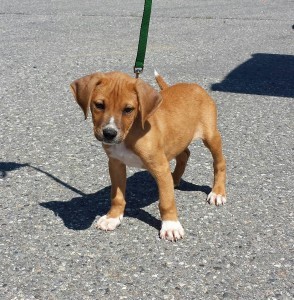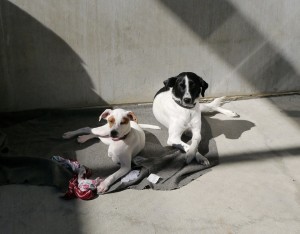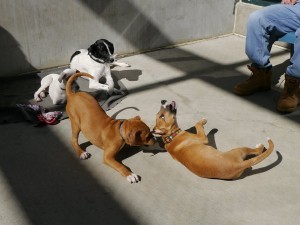Pups, Prison, and a Day in the Life
Jen Blood here, taking a break from informing the masses about the trials of indie publishing to tackle another subject very close to my heart. In September of this year, I got a rare but exciting opportunity to run with the big dogs, in the big house. Yes indeed… The Maine State Prison, in Warren. And before anyone gets up in arms about referring to the inmates as dogs, relax – I really mean dogs. Of the cuddly, furry, four-legged (or three-legged, in one case) variety.
At this point, prison programs that partner inmates with shelter dogs to assist with training before the pups are placed in forever homes are not really news. They’ve been around for decades, starting with a program spearheaded by Sister Mary Quinn in 1981. Since that time, these programs have gotten a lot of attention in the press for their ability to teach real-life skills while simultaneously promoting compassion and community mindedness in a prison setting. Since Quinn started the movement, a multitude of similar programs have sprung up around the country, with both inmates and prison staff citing shifts in inmate behavior, a decrease in tension among the prison population, and enhanced social skills between both the humans and the dogs onsite.

Logan, one of the pups in the K-9 Corrections Prison Program when I visited in September.
I’ve been aware of such programs for a while now, beginning when I first sat in on a training session with K-9 Corrections back in 2008. K-9 Corrections is a program operated through the Pope Memorial Humane Society of Knox County, pairing shelter dogs with inmates at the Maine State Prison in Warren. The program is run by dog trainer Marie Finnegan, who was mentoring me back in ’08 when I was finishing a dog training certificate program with Animal Behavior College.
Back then, the program was limited to one or two dogs who lived onsite at Bolduc Correctional Facility, the minimum-security prison just down the road from the Maine State Prison. Just over two years ago, Finnegan and K-9 Corrections were invited into MSP after being on a brief hiatus due to staff changes at Bolduc.
According to Finnegan, she’s been pleased to see how the program has developed since making the switch. “These guys really care about the dogs…and because they care about the dogs, they get to know the other trainers in the program… It’s a great way for everyone to relate to each other and start to communicate in a positive way.”
While I was excited to sit in on the session in 2008, it had very little in common with participating in the session at the Warren “Supermax” in September. There were forms to fill out, metal detectors to go through, pens and phones were surrendered, and then there was what felt like a very long walk down an echoing corridor with Finnegan and Case Worker Martha Boynton by my side. We ultimately ended up at a building that houses inmates under less restrictive guidelines than the neighboring buildings on the campus. I signed in at the central desk and waited as inmates began to file in. Not just inmates, though. Inmates with dogs.
The day I was there, there were five dogs and eleven trainers in attendance. The dogs ranged from pups like feisty Logan and the little three-legged spitfire Olive, to an aged Boston terrier named Charlie whose battle scars attest to the tough life she’s endured before being taken in by the Humane Society. A sweet but shy guy named Archer and the lovely Luna (papa and mama to Olive and seven other pups when they first came to HSKC) rounded out the program. I stood back while the guys ran the dogs through their paces, consistently impressed with how in tune the trainers were with their charges.

Olive and Archer — Archer is actually Olive’s dad. Here, I think you can definitely see a family resemblance.
When they come to the program, each dog is assigned a primary and secondary trainer. The dogs alternate between living and training with the primary and secondary trainers, which they do 24/7, sleeping in a crate in their cell, occasionally accompanying them to work or class, and then going out to exercise and work on training and socialization in the prison yard every day. Having a second trainer ensures that someone is always available if for any reason the other person on the team needs a break, works, or has an appointment where the dog isn’t able to come along.
Going through their paces, each training team that day would go up to the mat with their particular pup and demonstrate what they’d been working on for the week: sit, stay, down, come, and then a whole host of other tricks beyond the old standards, like twirl, moonwalk (you read that right), and wipe your paws (a tough one for Olive, who was born missing one of her front legs).
“People just take for granted that a dog can learn sit and stay,” says Finnegan, “even though some of those behaviors aren’t really that natural. But people assume a dog isn’t very smart unless he knows some tricks. Plus it’s good practice for the inmates to test their training chops.”
My favorite part of the afternoon comes when the training is done, however, and we’re able to go into the exercise yard. The yard looks much like a stereotypical prison yard you see in movies: concrete floor, concrete walls, a window too high up to reach, and a basketball hoop at one end. The dogs are able to go outside in the open air several times throughout the day, of course, but this yard is where the real fun is had, because it’s socialization time. Everyone is let off leash, and allowed to strut their stuff. Logan and Olive, the youngsters in the group, immediately race for one another and begin wrestling for all their worth. Archer, timid from the start, sticks close to his trainer, while Charlie — who hasn’t taken her eyes off her own trainer, Tom, since this session began — stays to the perimeter and Luna goes from person to person in search of treats and a little love.

Playtime in the yard with Olive, Archer, Logan, and Bobby, a pup added to the mix after my visit.
In the yard, I ask the guys one of the more obvious questions I can think of: How hard is it to say goodbye when the training is done?
“That’s the hardest part,” Tracy, Luna’s primary trainer, says immediately.
“It’ll just about break your heart,” agrees Tony, Logan’s primary. “Especially if there’s a lot of time before you get the next dog. Then your room just seems way too empty.”
“Do you think the program has changed you?” Marie asks the guys as we’re wrapping things up.
There is unanimous agreement, with the guys citing things like increased engagement, more tolerance, having a reason to get up every morning.
“It gives you a sense of humanity,” Ron tells me then. The others quiet a bit. Ron is Archer’s trainer – he’s a big, quiet man whose insight when it comes to his charge has impressed me from the start. “When I came here, there wasn’t much that got through to me. I was shut down. Then I started doing this, and all of a sudden something clicked.” The others in the yard seem to agree. “Having somebody rely on you everyday, give you that kind of love and look to you for what they need… That makes a difference.”
As we say our goodbyes, the trainers thank me for my time. The dogs are tired, their tails wagging as they make their way through the doors and back inside. Other inmates greet the weary pups with smiles. This is a dark place in a multitude of ways – I know that. It’s unlikely that the men who are here got here by stealing pies from someone’s kitchen window, after all. But it makes me feel a little bit better about the universe as a whole, that we as a society are coming to realize that some of the things that truly make a difference in our behavior and ability to engage with one another aren’t punishment and isolation… Positive interaction, clear expectations, compassion and contact and, yes, puppy dog tails, all really do go a long way in this world.
To learn more about the K-9 Corrections program, visit them on Facebook at http://facebook.com/K9Corrections/. Special thanks to Marie Finnegan for providing the photos in this post.



